Presentation Slides
https://docs.google.com/presentation/d/1vlg5PSw64f_f67qpsAjZtlEscNL4CFaQEN8BJwwBiYs/edit#slide=id.p
Concept and Plan
In the final project, we hope to discuss clothing as a communication tool for groups with mental disorders, specifically focusing on bipolar disorder (formerly called manic-depressive illness or manic depression), a mental illness that causes unusual shifts in a person’s mood, energy, activity levels, and concentration. Fashion has been a way of self-revelation and expression, while through exploring sensors and mechanisms, we could visualize the wearer’s mental and body changes, and help them communicate with people around them in a better and more unique way. Especially for Bipolars, they may find themselves yearning for intensive interactions and communications for some time, while later retreating to themselves and only wishing for a stable companionship. Based on my personal experience with my bipolar friend, they may find themselves trapped in a dilemma where they have a hard time balancing their mood and building stable friendships. Thus, our project hopes to visualize the mood cycle of bipolar and display their social life.
Later in the presentation and discussion with friends, we were inspired that the project could be more focused on how to help bipolar and other groups with mental disorders socialize. In other words, not just by demonstrating, but through the exploration of mechanisms and new materials, we could help the future design of clothes for people with mental disorders.
Mechanism and Prototyping
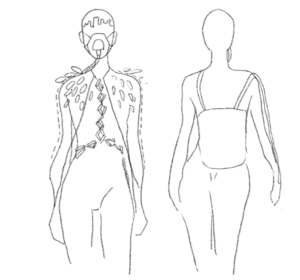
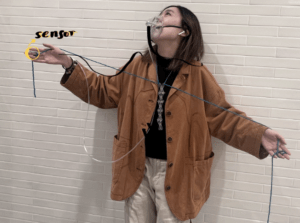
1️⃣ The Breathing Machine
(Including a mask, tubes, and pneumatic inflatables)
Silicone ➡️ Rubber fingertips ➡️ Silicone 2nd trial
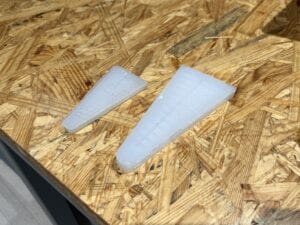
Luna and I made a silicone mold together under the guidance of Marcela in her remaker space. The process was divided into two parts, preparing the silicone (mixing A & B) and pouring the silicone into the laser-cut mold. Later, we tried out using the fingertips from the rubber gloves that we bought for previous assignments, and they worked very well in terms of imitating breaths, plus they were much easier to prepare and lighter to wear. However, we didn’t want to give up on silicone that quickly because we thought the material could create a better and more exaggerated visual effect. The next day after the presentation, we had a second trial. Inspired by a project that made a breathing skin, we decided to laser cut a mold by ourselves and experiment with something similar. I modeled and printed a few parts as the air layer, and Luna laser cut a square box as a silicone container. It turned out that though the second layer was very thin, it was still very hard to get the 3d modeled part out of it after it was done. We then switched to using baking paper as the air layer. Since the connecting parts were narrow and some were accidentally stuck together, it was a bit hard for the air to go through, and the visual effect at the end was not great. After two failed attempts, we went back to rubber fingertips 🙁 We planned to add more of them to test how many could two motors supply, and add variables like different textures and colors of rubber gloves.

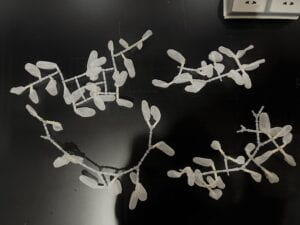
2️⃣ The Scissor Mechanism
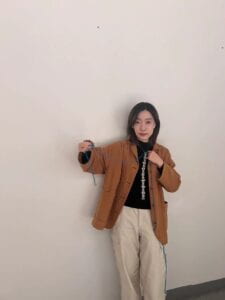
This part was inspired by our first pair work, a breath-taking embrace, a wearable prototype that
whenever you raise your arms for handshaking/hugging, the rubber band is tightened and the screws can cause pain. Using a scissor mechanism that we laser-cut and composed on our own, we adopted the same principle. When bipolar is reach out, they feel happiness (later there will be a sensor attached at the end of the wearer’s finger and a tube connecting the sensor and mask, indicating that the oxygen comes from the social life) and pain (bipolar know at the same time that they may alienate their friends during depression. The scissor mechanism is tightened when raising arms and it is chokin
g the wearer, shown in the video) at the same time.
3️⃣ Light & Sound (Planning)
We plan to use different lighting patterns with neopixels to indicate different stages of bipolar.
In Project1, we had some good experiments with sound (sensors & Arduino & Processing) and we decided to further develop sound art in clothes in the final project.
More details can be found in the slides.
4️⃣ Decoration
The wires in the rotation mechanism illustrate the mood cycle of bipolar very well, and we may use it as a head decoration.
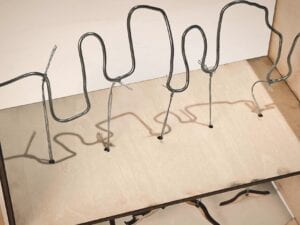
Reflection and Next Steps
1️⃣ A more nuanced & caring storytelling
During the presentation, some classmates pointed out that we should have done more research on Bipolar Disorder and talked to people who have it. In addition, some said that the symptoms of the disorder can vary from person to person. We also think that we didn’t do very well in terms of phrasing and expression. Given the limited time before the presentation, we could not prepare for detailed research. In the next one to two weeks, we plan to read some articles to better understand BD and organize a few interviews so that more caring storytelling can be presented in the final display.
2️⃣ Experiment more on the pneumatic mechanism
As said above, we are going to add more rubber fingertips to test out and possibly add more variables. Moreover, it might be challenging the organize the silicone tubes on the clothes, and we would take time to plan and design this part.
3️⃣ Add sensors
Sensors (for now, we are thinking about distance sensors) will be attached and the light & sound will be controlled accordingly.
4️⃣ Textile & design
We are going to think about the overall style and textile of the clothes.
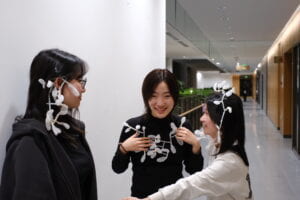
Reference
Grande, Iria, et al. “Bipolar Disorder.” The Lancet, vol. 387, no. 10027, Elsevier BV, Apr. 2016, pp. 1561–72. Crossref, https://doi.org/10.1016/s0140-6736(15)00241-x.
Little Red Book. “Bipolar Disorder Fashion.” Screenshot from Little Red Book.
Kang, K. W. personal communication, 2024.
Credits to
Marcela Godoy
Astroyd Kang
